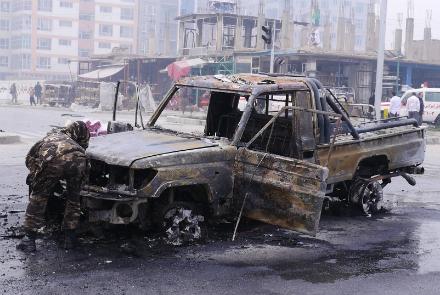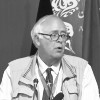Kabul is a city under siege. It may not be besieged in the way that Berlin was in April 1945, but the daily lives of its residents are overshadowed by a pervasive sense of fear as car bombs and magnetic mines are detonated on what seems a daily basis, some indiscriminate in their impact, others directly targeting proponents of pluralism, human rights and democracy. The ‘new Afghanistan’ that has developed over the last two decades is facing an unprecedented attack.
These atrocities have come in the midst of a so-called ‘peace process’. Yet if the aim of the process was to bring peace and security, something has plainly gone horribly wrong. To find agreements as flawed as the 29 February US-Taliban deal, one has to go to the Munich Agreement of September 1938, the January 1973 Paris Agreement on Vietnam, or the Arusha Accords on Rwanda of August 1993, which were hailed as triumphs at the time but now have few if any defenders. With the Afghan process paused, it pays to reflect on why the process has unravelled, and what other steps might best be pursued from this point.
A number of defects in the ‘peace agreement’ have already been widely noted and require little further attention – the exclusion from the negotiation process of the Afghan government; the absence of any reference to the Afghan government in the agreement; the lack of provision for a ceasefire of any kind; the lack of any Taliban commitment to human rights or democracy; and the provision for the release of up to 5000 Taliban combat and political prisoners without the consent of the sovereign government holding them in custody. From these very facts, it was patently obvious that for Washington the agreement was an exit agreement rather than a peace agreement.
In the period after 29 February, however, very serious problems of implementation also emerged. The most obvious related to the prisoner release issue, an ill-conceived ‘confidence-building measure’ which delayed the commencement of discussions between Afghan sides until 12 September. The main problem flowing from this was not, however, the return to combat activity of released Taliban, troubling though that was; it was rather that the disposition of the US consistently to give in to the Taliban’s interpretation of the agreement (for example, by treating the 5000 figure as a target rather than a ceiling, and supporting the release of war criminals as well as combat and political prisoners) sent the signal that the US was an enfeebled player that could be taken for granted. That this would be a problem was clear from 1 March when US Secretary of State Pompeo in an interview on CBS ‘Face the Nation’ described the 29 February text as ‘the complete agreement’, immediately freeing the Taliban from any commitments that they might have made in other unpublished documents.
In this context, the sharp escalation of attacks against civil society activists, journalists, and Afghanistan’s educated new generation is not at all surprising. With the Trump Administration focused on managing its own departure, the Taliban have had little or nothing to fear from President Trump or US envoy Dr Zalmay Khalilzad. The 29 February prohibition on attacks on US forces virtually invited an increase in attacks on Afghan targets. The Taliban have no interest in claiming responsibility for such attacks – knowing that their new American friends are uninterested in holding them to account, but might find such claims somewhat embarrassing. At the same time, they have a strong incentive to mount such attacks, in order to destabilise a government already vulnerable because of the looming US exit, and to keep their own combatants and networks on their toes for even-fiercer action once all US and allied personnel are gone.
This is why Dr Khalilzad’s supine failure to insist on a ceasefire in exchange for a US withdrawal timetable was such a catastrophic error, and his comments since then, typically not even calling out the Taliban for their recalcitrance, have been just as supine. Thus, on 16 October, Dr Khalilzad tweeted that ‘At present too many Afghans are dying. With the re-set, we expect that number to drop significantly’. This ‘warning’ was followed by a string of massive car bombings and major attacks, demonstrating either that the Taliban negotiators did not care a whit about the commitments that Dr Khalilzad thought they had made, or that the negotiators had no ability to control what the real power-holders were doing. Similarly, when Dr Khalilzad claimed that ‘Continued high levels of violence can threaten the peace process and the agreement and the core understanding that there is no military solution’, he begged the obvious question of whether the Taliban shared a ‘core understanding that there is no military solution’, a conviction which seemed increasingly delusional.
Where does this leave the ‘peace process’? To be blunt, it is increasingly clear that it has exhausted any potential it ever had to bring peace or security to Afghanistan. With hindsight, it veered off the rails at the point where Khalilzad abandoned the (defensible) ‘nothing is agreed until everything is agreed’ formula in favour of a two-stage process which gave the Taliban everything they really wanted – status, prisoner releases, and a US withdrawal timetable – at the first stage, creating no incentive for them to make any concessions during ‘intra-Afghan negotiations’. The Taliban have never shown the slightest disposition to be power-sharers, and there is no prospect that they will adopt such a position now, not least because their values are radically at odds with those of the supporters of a modernist, republican vision of Afghanistan’s future. US diplomacy has left them with the feeling that time is on their side and they are on a roll. What we are likely to see instead is strategic stalling on the Taliban’s part, and the illusion of active diplomacy. Delegations may bustle around, consulting with their principals, issuing statements, giving off-the-record briefings. But it will all be for show, and it is important for observers not to be deluded into mistaking this for progress.
No Afghan government is likely to pull the plug on this process, illusory though it may be. This would give a free-kick to Washington, which would undoubtedly hasten to blame the Afghan government for the collapse of the process, rather than accept any responsibility itself. But explicitly reframing the process as a marginal activity, peripheral rather than central to Afghanistan’s interests, would create space for more effective foreign policy settings, in terms both of the deployment of resources and the choice of issues to pursue. In respect of the former, foreign-policy resources are probably better devoted to working directly with sympathetic European governments, with international organisations, and with the incoming Biden administration. And in respect of the latter, a key issue to pursue – the real elephant in the room – remains the critical support that the Afghan Taliban receive from Pakistan and specifically from the Pakistan military. Meaningful peace and security will not come to Afghanistan until the issue of Pakistan’s relentless disposition to meddle in Afghanistan’s affairs is properly addressed, and it is wishful thinking to believe otherwise.
William Maley is Professor of Diplomacy at The Australian National University, and author of Transition in Afghanistan: Hope, Despair and the Limits of Statebuilding (2018), The Afghanistan Wars (3rd edition, 2021), and Diplomacy, Communication and Peace: Selected Essays (2021).
All are welcome to submit a fact-based piece to TOLOnews' Opinion page.
The views expressed in the opinion pieces are not endorsed or necessarily shared by TOLOnews.
Contributors are responsible for the accuracy of the information in an opinion piece, but if it is discovered that information is not factual, a correction will be added and noted.


